Introducing the Western Blot Learning Center
Perfect your western blotting. Learn from the experts.

On This Page |
Advantages of Digital Imaging | ChemiDoc Digital Imaging System | Publication Requirements | Designing Experiments | Resources | Related Products | Contact a Specialist |
X-ray film has long been considered the gold standard of sensitivity for western blot imaging, but the broad dynamic range enabled by modern digital imaging systems allows for accurate quantitation of a range of signal intensities equal to or better than film. With recent technological advances, can researchers finally have the best of both worlds?
Advantages of Digital Imaging for Western Blotting
Digital imaging systems provide many benefits over film:
- Wide dynamic range = 4 logs or better
- Quantitative imaging
- Digital documentation
- Environmentally friendly — no chemicals!
- No costly consumables (film and developing)
- Initial capital investment typically recovered
in as little as 1 year
See the Data: Digital vs. Film Western Blot Images
The sensitivity of film, with a broad dynamic range and superior signal-to-noise.
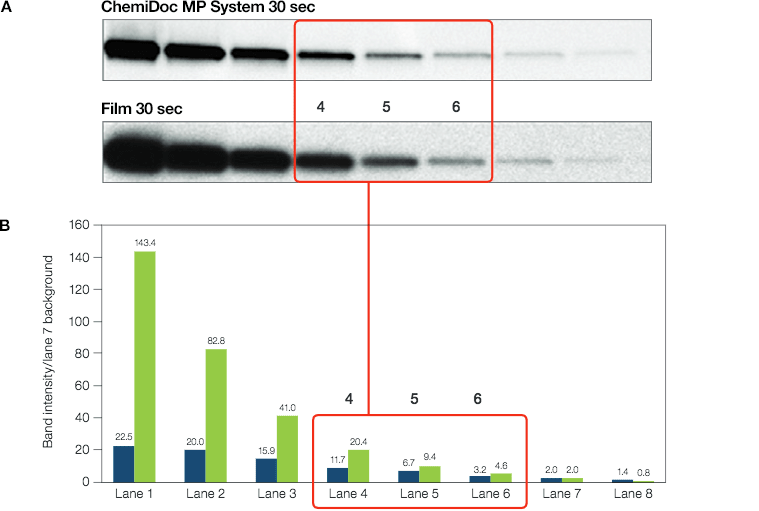
Comparison of sensitivity between the ChemiDoc MP Imaging System and film. A. Western blot analysis of LacI expression was conducted using 2x serial dilutions (starting at 0.31 μg protein) of E. coli cell lysate. The membranes were either imaged on the ChemiDoc MP Imaging System for 30 sec or exposed to film for 30 sec. B. Band intensities, normalized to lane 7 background, illustrate the ability of the digital imaging system to detect low signal bands at the same exposure time as film. The red boxes represent the limited linear dynamic range of film. ChemiDoc MP Imaging System, 30 sec ( ); film, 30 sec ( ).

Side-by-side comparison between the ChemiDoc Digital Imaging System and film. Levels of the three isoforms of the pro-apoptotic protein Bim were measured in various cell lines using western blot analysis. The membranes were either imaged on the ChemiDoc Imaging System for 30 sec or exposed to film for 30 sec to compare detection sensitivities. As shown by the overlay graph, the digital imaging system was better than film for detecting faint protein bands.
ChemiDoc Digital Imaging Systems
Imagine No Compromises
The ChemiDoc MP Digital Imaging System combines the superior quantitation of digital imaging with the sensitivity of film. This flexible digital imaging system replaces film in all light-detection applications, with the ability to perform general gel documentation, chemiluminescence detection, general gel documentation, multiplex fluorescent western blotting, and stain-free gel and blot imaging.
Complete Capabilities: Superior Images
Stain-Free
Total Protein Normalization
Learn how to properly design a quantitative western blotting experiment and faithfully compare protein expression levels, without concern for changing or overexpressed housekeeping proteins (HKPs).
See Data »
Chemiluminescence
Digital Imaging vs. Film
Save money on consumables and reduce environmental waste without compromising on performance. Get the sensitivity of film and the convenience of digital documentation.
See Data »
Multiplex Fluorescence
Three Color Digital Imaging
Save sample, avoid the errors commonly associated with stripping, reprobing, and cutting blots and answer more complex biological questions by optimizing your experiments to fluorescence.
See Data »
Publication Requirements
Need another reason to get out of the darkroom?
Several journals have recently revised their guidelines for publication, providing guidance around reproducibility and quantitation, requirements for data reporting, and specific recommendations on digital imaging of gels and quantitative western blots.
Defining the New Normal in Quantitative Western Blot Data
Learn why total protein normalization (TPN) is a superior method for quantitative western blotting analysis.
Publication requirements are changing. Are your blots ready?
-
1
"House-keeping proteins should not be used for normalization without evidence that experimental manipulations do not affect their expression"*
Solution: Use Total Protein Normalization (TPN) instead of house-keeping proteins
- Bio-Rad's stain-free workflow makes TPN easy! This technology is proven with over 100 publications, allows for improved accuracy and will make your data more reliable
-
2
"Methods including detection of enhanced chemiluminescence using X-ray film have a very limited dynamic range"*
Solution: Use a digital imaging system with up to 4 logs of dynamic range
- Bio-Rad's ChemiDoc System — an imager with the sensitivity of film
- Simple image generation and quantitation using Image Lab Software
-
3
"A description of the data supporting the specificity of all antibodies is required"*
Solution: Fully validated antibodies
- Bio-Rad's PrecisionAb Antibodies offer documented specificity and validation protocols
- Phospho-Specific PrecisionAb Antibodies are validated in treated and untreated cell lysates and by dephosphorylating western blot membranes
* Revised guidelines for authors from The Journal of Biological Chemistry
Total Protein Normalization provides accurate quantitation of target proteins.
Normalizing western blots with housekeeping proteins (HKPs) requires time, money, and additional sample to validate HKP expression and linearity. Total protein normalization using stain-free technology and a ChemiDoc Digital Imaging System allows normalization across a wide dynamic range. Get better, more publishable data without lengthy optimization.
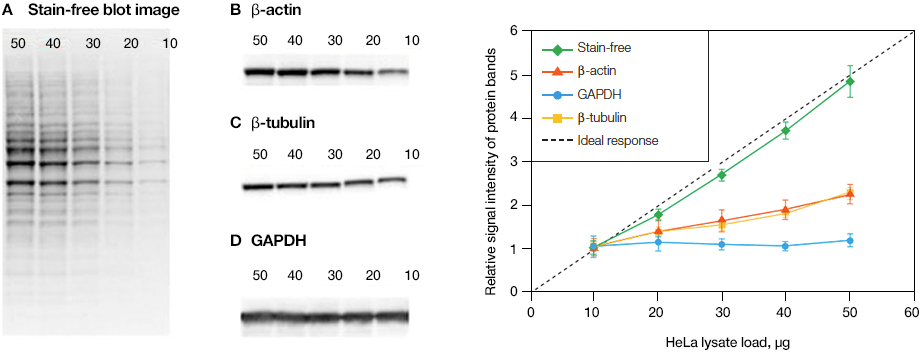
Linearity comparison of stain-free total protein measurement and immunodetection of three housekeeping proteins in 10–50 µg of HeLa cell lysate.
Learn more about Stain-free Technology
-
Trends in Protein Separation and Analysis — the Advance of Stain-Free Technology
This article focuses on the theory and concepts surrounding stain-free technology as well as other traditional methods of protein staining.
-
Stain-Free Imaging Technology
Visualize proteins on gels and blots without staining and destaining steps, and use total protein normalization for quantitative western blots.
Stain-Free Western Blotting
Stain-free western blotting allows you to quickly check electrophoresis and blot transfer quality and obtain truly quantitative western blotting results, updating traditional blotting techniques with innovative tools.
Faster Results. Better Data.
FEATURED PRODUCTPrecisionAb Validated Primary Antibodies
for Western Blotting
- Comprehensive selection of antibodies for cancer and neuroscience research
- Highly specific and sensitive
- Validated against up to 12 lysates
- Stringent QC criteria for superior consistency
Design your Western Blotting Experiments with Confidence
As an editor of several journals, Professor Aldrin V. Gomes routinely observes western blots that are not properly conducted. The generally low quality of western blotting data has led scientists to question whether we can trust protein quantification when using western blots. Reducing errors and misinterpretations requires standardized procedure and proper controls. Dr. Gomes discusses the following key factors for high-confidence western blot data:
- Quality of the primary and secondary antibodies and the blocking reagent
- Proper target protein controls
- Choice of total protein loading control vs. housekeeping protein loading control to normalize the target protein measurement
Prof. Gomes also presents tips to reduce the overall time required for first-rate western blots, and how to minimize the pain of going through a long procedure.
-
Reliable Quantification of Western Blot Data
Based on the article "A Defined Methodology for Reliable Quantification of Western Blot Data". Dr. S.C Taylor provides a direct comparison between results generated from camera-based imaging technologies and film using identical blots. Learn common pitfalls associated with film use and densitometric analysis.
This video is based on the article published by S.C. Taylor et al. entitled "A Defined Methodology for Reliable Quantification of Western Blot Data" (DOI 10.1007/s12033-013-9672-6).
-
Designing a Quantitative Western Blot Experiment to Avoid Common Pitfalls
The quantitative western blot methodology is described with a focus on solid experimental design and data analysis to achieve reproducible, publication quality results in the shortest time frame.
This video is based on the article published by Drs. Taylor and Posch entitled: "The Design of a Quantitative Western Blot Experiment".
-
Quantitative Western Blotting: Optimization is the Key
Dr. S.C. Taylor details the common errors associated with performing quantitative western blots and how they can be addressed through a rigorous optimization methodology. Each step of the quantitative western blot workflow is discussed with a focus on optimization to assure quantitative, reproducible final data that reflect the experimental conditions.

Testimonial
Leukemia researcher Ernesto Diaz-Flores (University of California, San Francisco) describes how the ChemiDoc Digital Imaging System helped him improve his western blot imaging, enabling him to identify relevant therapeutic targets. An avid photographer, Prof. Diaz-Flores also talks about the links between his art and his science and the technologies that help him achieve his goals in both fields.
Resources
FEATURED WEBINARUnderstand the Factors that are Crucial to Successful Western Blotting

Join Bio-Rad western blotting expert Kenneth Oh and his guest speakers for a webinar series that explores the many factors that go into the design and execution of successful and repeatable western blots. Chemiluminescence or fluorescence, qualitative or quantitative western blot, not only will we discuss the how-tos, we'll take a deeper dive and discuss the whys.
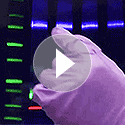
Image Lab Touch Software Resources
Bio-Rad provides instructional videos for Image Lab Touch Software 2.4, covering the primary applications of the ChemiDoc MP Digital Imaging System. Topics include logging in, Smart Tray Technology, capturing your image, and exporting data.
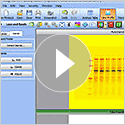
Image Lab Software Resources
Bio-Rad provides tutorials for basic digital image acquisition and advanced analysis with Image Lab Software. Topics include densitometric analysis, molecular weight, normalization, purity assessment, and more!
Application Guides

Western Blot Doctor Troubleshooting Guide
Our self-help troubleshooting guide covers solutions to many common and not-so-common western blotting issues and helps your blots look their best.

Protein Blotting Guide
(PDF 7.9 MB)Details on blotting technology, available products, and methods, plus tips, techniques, and troubleshooting.
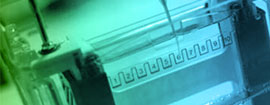
Electrophoresis Guide
(PDF 6.4 MB)A guide to polyacrylamide gel electrophoresis and protein detection, including theory, product selection, protocols, and more.
Documents Library

ChemiDoc MP System Brochure
(PDF 1.26 MB)Explore the features and benefits of the new high-end imaging system for the best fluorescence and chemiluminescence detection.

Stain-Free Approach to Western Blotting
(PDF 864 KB)Learn how to use stain-free technology for total protein normalization as an alternative to the standard blot normalization process.

V3 Western Workflow Brochure
(PDF 593 KB)See how the V3 Western Workflow compares to traditional western blotting workflows.

Determining the Appropriate Sample Load When Using a Stain-Free V3 Western Workflow
(182 KB)
Validating the Expression Consistency of a Housekeeping Protein
(198 KB)
Publications
-
A Defined Methodology for Reliable Quantification of Western Blot Data
Learn about the methodology to obtain reliable quantitative data from chemiluminescent western blots using standardization procedures coupled with the updated reagents and detection methods.
-
The Design of a Quantitative Western Blot Experiment
Read a summary about a complete western blot workflow with a focus on sample preparation and data analysis for quantitative western blotting.
Related Products
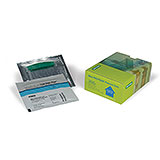
Mini-PROTEAN TGX Stain Free Precast Gels
Mini-PROTEAN TGX Stain Free Precast Gels for polyacrylamide gel electrophoresis (PAGE) allow for fast run times, high transfer efficiency, and rapid detection of proteins with stain-free enabled imagers.
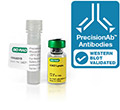
PrecisionAb Validated Western Blotting Antibodies
These premium antibodies are lab-validated using strict testing criteria to ensure superior performance in western blotting detection.

Trans-Blot Turbo Transfer System
The Trans-Blot Turbo System is a rapid protein transfer apparatus that can transfer protein to membrane in as little as 3 minutes. Trans-Blot Turbo Transfer Packs provide greater transfer efficiency in less time.
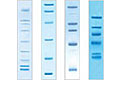
Protein Ladders and Standards (Markers)
Prestained and unstained molecular weight standards for protein electrophoresis applications including SDS-PAGE, western blotting, 2-D PAGE, and isoelectric focusing (IEF).

Clarity ECL
Clarity family of Western ECL Substrates provides simple, high-performance solutions for all your western chemiluminescence needs.

SureBeads Protein G Magnetic Beads
SureBeads Protein G Magnetic Beads enable fast, easy, consistent immunoprecipitation without centrifugation.



